The American System-Built Homes were modest houses in a series designed by architect Frank Lloyd Wright. They were developed between 1911 and 1917 to fulfill his interest in affordable housing but were sold commercially for just 14 months. The Wright archives include 973 drawings and hundreds of reference materials, the largest collection of any of single Wright project. Wright cancelled the project in July 1917 by successfully suing his partner Arthur Richards for payments due and didn't speak of the program again. The designs were standardized and modular, so customers could choose from one hundred and twenty nine models on seven floorplans and three roof styles. Most materials were prepared and organized at Arthur Richards' lumber yard, so there was less waste and specialized labor needed for construction. Milled and marked materials were delivered to the work site for cutting and assembly by a carpenter. Windows, doors and some cabinetry were built at the yard. Frames, shelves, trim and some fixtures were cut and assembled on site. Most wood parts had a part number and corresponding instructions and drawings for joining, fit and finish. Richards' yard also supplied plaster, concrete, paint and hardware.
To minimize materials and job site labor, Wright used twenty-four inch (on center) distances between studs and oversized joists and a commercially-available, pre-milled structural lath called "Byrkit" to bridge unsupported sections. These choices enabled standardized 21' 1/2" wide casement windows from 26 to 64 inches high to be hung between studs without need for headers. Oversized 12 by 2 inch floor and ceiling joists and Byrkit lath are key identifying features in the search for Wright's ASBHs lost or forgotten.
Many extant homes remain in private hands and an ad hoc homeowners group gathers to share ideas. Six structures are located in a federal historic district in Milwaukee, Wisconsin, and others have been designated Chicago Landmarks in Chicago, Illinois.
Background and History
In 1911, Arthur L. Richards and a partner contracted with Frank Lloyd Wright to design a hotel in Lake Geneva, Wisconsin and Richards learned of Wright's idea to offer a family of residential housing designs that would share style, parts and pieces.
In 1914, the young architect Russell Barr Williamson joined Frank Lloyd Wright's studio and was tasked as the main draftsperson on the project. Williamson kept a register of models and features and was responsible for creating and issuing the construction drawings required by a contractor to build a house, when one was sold.
In 1914-15, Richards purchased four designs and built six buildings in a demonstration neighborhood and investment in Milwaukee, Wisconsin, now called the "Burnham Block", for short. In 1916, Wright and Richards signed a commercial contract giving Richards the exclusive rights to manufacture and distribute the homes and Wright the job of design and specification. Richards sold franchises to market the homes and planned to allow only approved contractors to build them, though some homes were built independently. Richards had offices in Milwaukee, the Chicago area, Champaign, Decatur and Gary. The customer purchased a completed home, sometimes directly from The Richards Company, or alternatively, from speculators to whom Richards had sold plans and materials.
In July, 1917, Wright, dissatisfied with Richards, fearing loss of intellectual property, and with World War I as cover, sued for nonpayment of royalties and fees, and the project came to an end, though the court found that home construction started before ruling could be completed.
Williamson was let go or left Wright's studio when the project was cancelled and then teamed with Richards to continue designing and selling Prairie School and more conventionally-designed homes using standardized practices under the short-lived brand "American Renaissance Homes", Richards Real Estate and other companies. Wright, meanwhile, walked away from Prairie Architecture to focus on and finish his Imperial Hotel, Tokyo project and transition his own designs to include Mayan and Asian influences.
It is believed that about 25 System-Built Homes were constructed, but only 12 are known to have survived. They can be found in Wisconsin, Illinois, Indiana, and Iowa.
Prototype Burnham Street Historic District, Milwaukee
United States historic place| Prototype American System Built Homes-Burnham Street District | |
| U.S. National Register of Historic Places | |
| U.S. Historic district | |
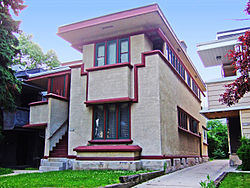 Model F Duplex Model F Duplex | |
  | |
| Location | Milwaukee, Wisconsin |
|---|---|
| Coordinates | 43°0′38″N 87°56′55″W / 43.01056°N 87.94861°W / 43.01056; -87.94861 |
| Area | 0.5 acres (0.20 ha) |
| Built | 1914 – 1915 |
| Architect | Frank Lloyd Wright |
| Architectural style | Prairie Style |
| NRHP reference No. | 85002166 |
| Added to NRHP | September 12, 1985 |
Six demonstrator homes were built speculatively in the Burnham Park neighborhood of Milwaukee by Arthur Richards in 1915-16 and were added to the National Register of Historic Places in 1985. There are four model 7a duplexes, a model B1 bungalow, and a model C3 bungalow. It is the only grouping of Frank Lloyd Wright-designed homes that includes both duplexes and single-family dwellings. Three of the homes have been purchased by the Frank Lloyd Wright Wisconsin Program. The B1 bungalow was restored in 2010, with one of the duplexes to follow. They are located in the 2700 block of West Burnham Street, at South Layton Boulevard.
Richards' Burnham Block served as a testing ground for Wright's ideas, informing the formal contract and branding that ramped up starting in 1916. Therefore, details found in the prototype homes and the commercial homes are different. Elements found in the Burnham block but not in commercial homes can be seen as experimental. Elements found only in commercial homes can be seen as refinements of the system.
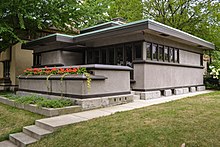
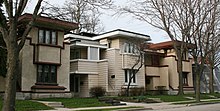
Prototype American System Built Homes in the Burnham Street District:
- Arthur L. Richards Duplex Apartments - referred to as either "Model 7a Duplexes", "Model C" or "Model F" - 4 units, 3 identical units (2720-2730 West Burnham), the 4th unit (2732-2734 West Burnham) is a mirror image. The second house from the west has been converted to a single family home. Built 1915.
- Arthur L. Richards Small House - "Model B1" or "Cottage B" located at 2714 West Burnham Street. Built 1915.
- Richards Bungalow - "Model C3" or "Cottage A" located at 1835 South Layton Boulevard. Built 1915. This house was resurfaced in precast coral stone veneer in 1956.
The Munkwitz Apartments, Milwaukee
The Arthur R Munkwitz Duplex Apartments were pair of four-unit apartment buildings built in 1916. The Munkwitz Duplexes were based on an American System-Built Homes plan and constructed on 1102-1112 N. 27th Street under the supervision of Russell Barr Williamson. They were demolished in 1973 to widen the street.
Commercial American System-Built Homes in Illinois, Wisconsin and Iowa
Commercial ASBHs are homes started under the Wright-Richards contract and built by contractors to Wright's specification with material supplied by Richards.
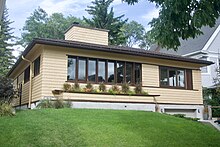


Single story, single family units:
- Lewis E. Burleigh House - Wilmette, Illinois (1915)
- Ida and Grace McElwain House - Lake Bluff, Illinois (1915)
- The Elizabeth Murphy House (A203) - Shorewood, Wisconsin (1917)
- Stephen M. B. Hunt House II - Oshkosh, Wisconsin (1917)
Two story, single-family units:
- Wilbur Wynant House - Gary, Indiana (1916)
- Oscar A. Johnson House - Evanston, Illinois (1917)
- A.B. Groves House (AA202) - Madison, Wisconsin (1917)
- Delbert W. Meier House - Monona, Iowa (1917)
- Charles Heisen House - Villa Park, Illinois (1917)
Chicago Landmark Homes
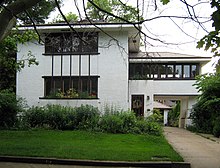

On July 13, 1994, the Mayor and City Council of Chicago designated two System-Built Homes as Chicago Landmarks. Built in 1917, they are located at 10410 (the Guy C. Smith House) and 10541 S. Hoyne Avenue (the H. Howard Hyde House). The first, at 10410 Hoyne, was intended to be the first of a subdivision of the homes and was built and sold speculatively. Both the Smith and Hyde Houses are two story, single-family units.
Suspected but not verified
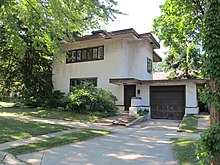
In 2008, Wright scholar, William Allin Storrer unveiled his controversial 29 undiscovered Frank Lloyd Wright works. One of these houses was the Thomas E. Sullivan House at 336 Gregory Avenue in Wilmette, Illinois, next door to the Burleigh House at 330 Gregory Ave. In 1989, Storrer had previously identified the 1916 house as the work of John S. Van Bergen even though the residence does not appear in Martin Hackl's complete catalog, The Works of John S. Van Bergen, Architect. In his 2008 findings, Storrer revised his claim, then stating that the Sullivan House was actually an American System-Built Home with a dining room addition by Van Bergen. Excluding the alleged addition, the main block of the Sullivan House is nearly identical to that of the Wynant House; only the entrance and garage orientation, a missing bedroom above the garage, and differences in trim details distinguish these two residences. Storrer's assertion is further substantiated by a drawing from the Frank Lloyd Wright Foundation which shows Model D-101 with the Sullivan House entrance and without the Wynant House garage wing.
Storrer also identified three potential single-story American System-Built Homes in Berwyn, Illinois. One, the Chester Bragg House (1916), is located at the 6644 34th Street at the corner of Wesley Avenue and has a Model B1 plan.
See also
- List of Frank Lloyd Wright works
- National Register of Historic Places listings in Milwaukee County, Wisconsin
- List of Chicago Landmarks
Notes
- "The Homes: Model B1, 2714 West Burnham". Wright in Milwaukee. Frank Lloyd Wright Wisconsin Tourism Heritage Program. 2010. Retrieved June 11, 2010.
- ^ Hayes, Nicholas (April 1, 2023). Frank Lloyd Wright's Forgotten House. University of Wisconsin Press. ISBN 9780299331801. Retrieved November 2, 2023.
- Bleiberg, Larry (June 7, 2015). "10 Great: Frand Lloyd Wright Homes". USA Today.
- ^ . Lilek, Michael (2005). "The American System-Built Homes in Milwaukee, Wisconsin: Frank Lloyd Wright's earliest system of low-cost housing". Wright in Milwaukee. Frank Lloyd Wright Wisconsin Tourism Heritage Program. Archived from the original on 23 May 2010. Retrieved 11 June 2010.
- "How to Build a Warm, Strong, Dry House", Byrkit-Hall Sheating Lath Co., 1890, Retrieved 8 Oct 2024, https://archive.org/details/HowToBuildAWarmStrongAndDryHouseByrkitsPatentSheathingLath
- "ASBH Owners Organize", https://elizabethmurphyhouse.com/2021/03/09/asbh-owners-organize-and-invite-others-to-join-in-stewardship/, Retrieved 10 Jan 2024.
- Elias, Juanita M. "Prairie School Architecture in Milwaukee, Russell Barr Williamson". (Masters Thesis, University of Wisconsin, Milwaukee, 1974
- "Frank Lloyd Wright vs. The Richards Company". Dane County Circuit Court Case Files. Wisconsin Historical Society.
- Shirley du Fresne McArthur (January 15, 1985). "NRHP Inventory/Nomination: American System Built Homes-Burnham Street District". National Park Service. Retrieved June 11, 2010. With 22 photos.
- "American System Built Homes-Burnham Street District". Wisconsin Historical Society. January 2012. Retrieved May 22, 2019.
- "The Homes". Wright in Milwaukee. Frank Lloyd Wright Wisconsin Tourism Heritage Program. 2010. Retrieved June 11, 2010.
- ^ "Historic designation study report - American System Built Homes Historic District" (PDF). City of Milwaukee Department of City Development. January 8, 2001.
- "Richards Duplexes". Wisconsin Historical Society. Retrieved May 22, 2019.
- "Arthur L. Richards House". Wisconsin Historical Society. Retrieved May 22, 2019.
- "R.E. City and Frank Huschek House". Wisconsin Historical Society. Retrieved May 22, 2019.
- "American System-Built Houses". City of Chicago Department of Planning and Development, Landmarks Division. Retrieved July 13, 2011.
- ^ Storrer, William A. (2008). "The 29=30 discovered works". FLLW Update. Retrieved June 11, 2010.
- Wagner, Andrew (December 2000), "There is Too a There There Too: Gary, Indiana" (PDF), Dwell Magazine, p. 74, retrieved June 11, 2010
- "6644 34th Street Berwyn, IL 60402". BlockShopper Chicago. 2010. Retrieved June 11, 2010.
References
- Storrer, William Allin. The Frank Lloyd Wright Companion. University Of Chicago Press, 2006, ISBN 0-226-77621-2 (S.200, S.201, S.202, S.203, S.204)
- Hayes, Nicholas Dale. Frank Lloyd Wright's Forgotten House. University of Wisconsin Press, 2021, ISBN 9780299331801
External links
- Frank Lloyd Wright's Burnham Block on Atlas Obscura
- Wright in Milwaukee
- 600 Fillmore, Gary, Indiana
- Plan of model C3
- The Elizabeth Murphy House
- Richards Bungalow on dgunning.org
- H. Howard Hyde House
- H. Howard Hyde house on peterbeers.net
- H. Howard Hyde house on dgunning.org
- Guy C. Smith House
- Guy C. Smith house on peterbeers.net
- Guy C. Smith house on dgunning.org
- Frank Lloyd Wright 'American System-Built Houses' (American System Ready-Cut) 1911 - 1917, ONLINE SOURCES:
- 2720 West Burnham Street in the Library of Congress
- is an example of Wright's plans and drawings that the Wisconsin Historical Society has online. To see others, enter "American System-Built" in the Search at the top of that page.
| U.S. National Register of Historic Places | |
|---|---|
| Topics | |
| Lists by state |
|
| Lists by insular areas | |
| Lists by associated state | |
| Other areas | |
| Related | |
| Chicago Landmark houses | |
|---|---|
| National Historic Landmark, National Register of Historic Places, Chicago Landmark | |
| National Historic Landmark, National Register of Historic Places | |
| National Register of Historic Places, Chicago Landmark | |
| Chicago Landmark |
|
- 1910s architecture in the United States
- Beverly, Chicago
- Chicago Landmarks
- Frank Lloyd Wright buildings
- Historic districts on the National Register of Historic Places in Wisconsin
- Houses in Chicago
- Houses in Milwaukee
- Houses on the National Register of Historic Places in Wisconsin
- National Register of Historic Places in Milwaukee
